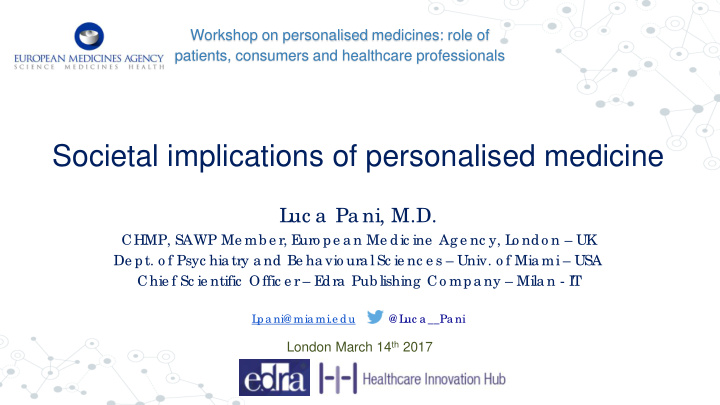



Workshop on personalised medicines: role of patients, consumers and healthcare professionals Societal implications of personalised medicine L uc a Pa ni, M.D. CHMP, SAWP Me mb e r, E uro pe a n Me dic ine Ag e nc y, L o ndo n – UK De pt. o f Psyc hia try a nd Be ha vio ura l Sc ie nc e s – Univ. o f Mia mi – USA Chie f Sc ie ntific Offic e r – E dra Pub lishing Co mpa ny – Mila n - I T L pa ni@ mia mi.e du @ L uc a __Pa ni London March 14 th 2017
Disclaimer and Disclosure* The opinions expressed in this presentation are the personal views of the Author and may not be understood or quoted as being made on behalf of or reflecting the position of the Italian (AIFA) or European (EMA) Medicines Agency or any of their Committees. The mention of commercial products, their sources, or their use in connection with material reported herein is not to be constructed as either an actual or implied endorsement of such products by any Public Department or Health and/or Payer Services. * See also the Revised Conflict of Interest Regulations approved by AIFA Board of Directors (25.03.2015) and published on the Official Journal of 15.05.2015 according to EMA policy /626261/2014 on the handling of the conflicts of interest for scientific committee members and experts. For this presentation I receive no compensation only travel reimbursement.
Biology has now become a science of information and we must change our cultural reference framework (Leroy Hood, 2003) • Atlas of Protein Structure: M. Dayhoff • 1965 1 year work (720 Kb), all the world’s lab • 2003 30’ (1 Gb), 1 Robot 1925-1983 • 2017 0.001’ (127.352 macromolecules) http://www.rcsb.org/ • DNA Sequence: The PAM250 Matrix • 1986 250 bp a day, 1 Robot • 2003 1.500.000 bp a day, 1 better Robot (98 M$ genome) • 2017 3.000.000.000 bp a day 1 HT-Sequencing ( 1,000 $)
Biology and Medicine are now dead Sciences, they have become Information Sciences 2011 Predictive, personalized, preventive, participatory (P4) … Leroy Hood & Stephen H. Friend Nature Reviews Clinical Oncology 8 , 184-187 (March 2011)
Personal and Human Population Numbers ◎ Earth's population = 7 billion people ◎ Exponential growth started only 200 years ago ◎ Between year 1000 and 2000 it grew 3 times faster ◎ In the last 100 years it increased from 1,5 billion to 6 ◎ Life expectancy increased by more than 35 years
Human Population Growth: Future Trend
The personal revolution: number and types of devices
Will generate 40 ZettaBytes of Healthdata by 2020 What are we talking here really? If 1 byte equals a grain of rice, then 1 Zettabyte will fill the Pacific Ocean with rice.
Information and Internet of everything AI Applications in Healthcare Growing Dramatically ◉ Healthcare Research ◉ Drug Discovery ◉ Insights & Risk Mgt. ◉ Virtual Assistants ◉ Imaging & Diagnostics ◉ Wearables ◉ Lifestyle Mgt & Monitoring ◉ ER & Hospital Mgt. ◉ Mental Health
Type and size of data Data ≸ information ≸ knowledge 41% 62% 58% TRANSITIONING FROM SYSTEMS CANNOT GROWTH OF DATA TO KNOWLEDGE IS A PROCESS LARGE UNSTRUCTURED, NON- MAJOR CHALLENGE 1 CONTEXTUALIZED DATA 2 VOLUMES OF DATA FROM DIFFERENT SOURCES Courtesy of William King, CEO of Zephyr Health (modified) 1 PwC 5TH annual IQ survey 2 International Data Group Research
Innovative data analysis models could be game changer Traditional, relational Entity centric model model Entity Data Data Data Attributes table source 1 source 2 source n Meta data Entity Programmatic data Attributes transformation: …… …… Deep Learning …… Entity …… …… …… Attributes …… …… …… Billions of data Entity …… connections made …… …… Courtesy of William King, CEO of Zephyr Health (modified)
From internet of everything to customerization of everybody What is one of the Giant thinking and doing?
Apple: mHealth ◉ ResearchKit, real-world research laboratory ◉ 5 app of mHealth aimed to Parkinson's disease, diabetes, cardiovascular disease, asthma and breast cancer track ◉ Recording information very useful post market studies involving large numbers of individuals over vast geographical areas ◉ Data collected every second remotely
New Technologies: PatientsLikeMe PatientsLikeMe ◉ A network and at the same time a research platform ◉ Through the network, patients may remain in contact with other patients ◉ Sharing the experiences ◉ Opportunity to learn from the aggregate data of others and see other types of treatments
PatientsLikeMe With nearly 500,000 members, PatientsLikeMe is a reliable source of information on diseases and it allowed the publication of more than 80 research studies.
Societal Implications for new answers to new demands ◉ New organizational model ◉ Innovation in life sciences and biotech ◉ Possibility of avoiding recurrence of diseases ◉ Introduction and monitoring of selective drugs ◉ Preventive personalised medicine aimed at healthy individuals at risk
Continuous & ambient user experience Moving toward a postApp Era Separate apps on separate devices App Integration w. notifications providing contextual links Intelligent assistants provide basic control and automation New "app platforms" and services emerge Wearables drive context and interactions App & collaboration across devices Fluid, contextual, conversational 2014 2020 We are here
Information of everything + advanced machine learning + advanced systems The Perfect Storm Ignited the Smart Machine Revolution Reflect a Well- Deal With Scoped Purpose Complexity Appear to Understand Actively Adapt Passively Learn Make Act Autonomously Predictions
In conclusion: Societal Implications of Personalised Medicine ◉ The most important innovation disrupter: i.e. the ITC impact on an expanding set of end-user devices is here now ◉ This will challenge and force all of us to rethink how data-information- knowledge are being created and used ◉ Business models will evolve (fast) thanks to smart machine technologies ◉ We must augment perimeter defense and rule-based security detection with user and entity behavior analytics ◉ The difference, if any, between patients and consumers is fading away
Recommend
More recommend